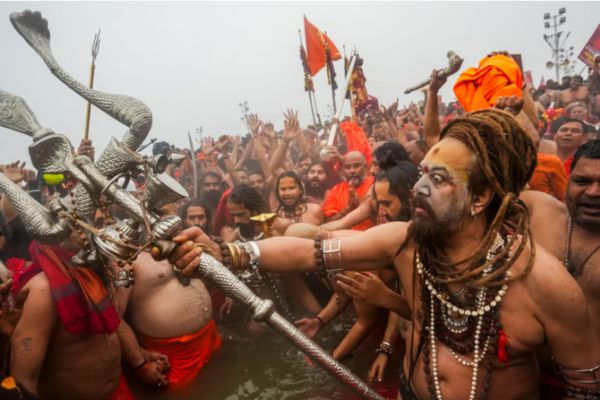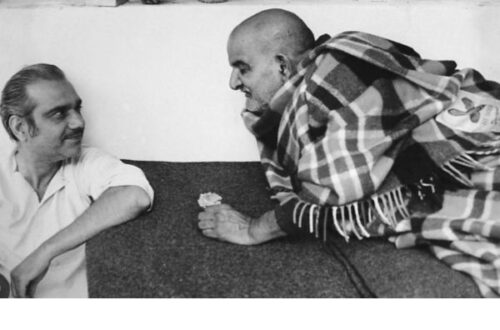
Unveiling the Mystique of Naga Sadhus: Warriors of Spirituality
In the diverse tapestry of Indian culture and spirituality, the Naga Sadhus stand out as one of the most enigmatic and intriguing groups. Known for their fierce appearance, rigorous ascetic practices, and unwavering devotion, these holy men have captivated the imagination of people around the world. In this blog post, we delve into the fascinating world of Naga Sadhus, exploring their origins, lifestyle, and some intriguing facts that make them truly unique.
Who Are the Naga Sadhus?
Naga Sadhus are a sect of Hindu ascetics who dedicate their lives to spiritual pursuits, renouncing worldly pleasures and material possessions. They are primarily associated with Shaivism, worshipping Lord Shiva as their supreme deity. The term ‘Naga’ means ‘naked,’ reflecting their practice of discarding clothing to symbolize their detachment from the material world.
Origins and History
The origins of Naga Sadhus can be traced back to ancient times when they were formed to protect the faith and uphold Dharma (righteousness). Historically, they were known to be warrior ascetics, often taking up arms to defend their religious beliefs and sacred sites. Today, their militant past is commemorated in their ceremonial practices and rituals.
The Life of a Naga Sadhu
Becoming a Naga Sadhu is not a simple process; it requires rigorous training, discipline, and a deep commitment to spirituality. Here are some key aspects of their lifestyle:
| Aspect | Description |
|---|---|
| Initiation Ceremony | The journey begins with an initiation ceremony, known as ‘Diksha,’ involving intense rituals and symbolic renunciation of their past life. |
| Ascetic Practices | They practice extreme forms of asceticism, including meditation, fasting, and living in harsh conditions. They often reside in remote locations like mountains and forests to focus on their spiritual growth. |
| Celibacy and Renunciation | Naga Sadhus take vows of celibacy and renounce all personal possessions, including clothes, signifying their detachment from material life. |
| Spiritual Disciplines | Their daily routine includes hours of meditation, chanting, and rituals aimed at achieving spiritual enlightenment and liberation (moksha). |
Intriguing Facts About Naga Sadhus
| Fact | Details |
|---|---|
| Kumbh Mela | Naga Sadhus are one of the main attractions at the Kumbh Mela, the largest religious gathering in the world. Their dramatic entry into the Ganges for a holy dip is a sight to behold. |
| Ash-Covered Bodies | They smear their bodies with ash from sacred fires, which is believed to have spiritual significance and to protect them from the elements. |
| Unique Hairstyles | Many Naga Sadhus grow long, matted hair known as ‘Jata,’ symbolizing their spiritual strength and renunciation. |
| Martial Arts Skills | Despite their spiritual focus, Naga Sadhus are trained in martial arts and traditional weaponry, a nod to their warrior heritage. |
| Guru-Disciple Tradition | The relationship between a Naga Sadhu and their guru is deeply revered, with the guru guiding the disciple through their spiritual journey. |
| Fire Worship | Naga Sadhus often worship Agni (fire) as a representation of purification and divine energy. Their rituals around fire are deeply symbolic and significant. |
| Extreme Weather Resilience | They live in extreme conditions, including the freezing cold of the Himalayas, showcasing their mental and physical resilience. |
| Minimalist Lifestyle | Their belongings often consist of just a loincloth, a Rudraksha mala (prayer beads), and a trident, symbolizing simplicity and detachment. |
| Pilgrimage and Wandering | Naga Sadhus are known for their nomadic lifestyle, constantly moving between sacred sites and pilgrimage centers, embodying the spiritual ideal of detachment. |
| Use of Cannabis | Some Naga Sadhus use cannabis (bhang) during their rituals, believing it aids in meditation and connects them more closely with Lord Shiva. |
FAQs About Naga Sadhus
Q1: Are Naga Sadhus completely isolated from society?
Not entirely. While they prefer solitude for spiritual practices, they do interact with society during religious festivals and gatherings like the Kumbh Mela.
Q2: Why do Naga Sadhus live without clothes?
Living without clothes symbolizes their complete detachment from materialistic life and their commitment to spiritual purity.
Q3: Can anyone become a Naga Sadhu?
In theory, yes. However, it requires intense training, a guru’s mentorship, and a lifetime commitment to ascetic practices.
Q4: What is the significance of the ash on their bodies?
The ash represents their connection to Lord Shiva, who is often depicted covered in ash. It also signifies the transient nature of the physical body.
Q5: How do Naga Sadhus sustain themselves?
They rely on alms and donations from devotees, and their needs are minimal due to their ascetic lifestyle.
Q6: What do Naga Sadhus eat?
Their diet can vary. While many Naga Sadhus follow a vegetarian diet, some may consume non-vegetarian food depending on their sect or personal practices. Regardless, their diet is typically simple, and they often engage in fasting as part of their spiritual discipline.
Q7: Do Naga Sadhus have any festivals they celebrate?
Yes, besides the Kumbh Mela, they observe Shivaratri, a festival dedicated to Lord Shiva, with great fervor. It is a day of fasting and night-long vigils and prayers.
Q8: How do Naga Sadhus contribute to society?
Though they live an ascetic life, they often serve as spiritual guides and mentors. Their presence in religious gatherings helps to inspire and reinforce faith among the masses.
Q9: What weapons do Naga Sadhus use in their martial arts?
They are skilled in using traditional Indian weapons like tridents (trishul), swords, and spears, which are often used in ceremonial displays.
Q10: Do Naga Sadhus follow a specific diet?
Their diet varies, with some adhering to vegetarianism, while others may eat non-vegetarian food. They often fast as part of their spiritual practices, emphasizing simplicity and minimalism in their meals.
Q11: Where do Naga Sadhus actually live?
Naga Sadhus typically reside in remote areas like caves, forests, and mountains, where they can practice their ascetic lifestyle in peace. They are also known to stay in ashrams or Akharas, which are monasteries that provide them with a community of fellow ascetics.
Some of the most notable Akharas where Naga Sadhus reside include:
- Juna Akhara: One of the largest and oldest Akharas, it plays a significant role in the Kumbh Mela.
- Mahanirvani Akhara: Another prominent Akhara known for its historical and spiritual significance.
- Niranjani Akhara: Famous for its strict adherence to ascetic practices and rituals.
- Atal Akhara: Known for its learned scholars and spiritual teachings.
These Akharas are located in various parts of India, with significant centres in Haridwar, Varanasi, and Allahabad, where they engage in spiritual learning and practice.
Q12: Are Naga Sadhus different from Aghori Babas?
Yes, Naga Sadhus and Aghori Babas are different sects with distinct practices and beliefs. While both are ascetics and followers of Lord Shiva, Aghori Babas are known for their unconventional and extreme practices, such as meditating in cremation grounds and using human skulls in rituals. In contrast, Naga Sadhus focus more on traditional asceticism, martial arts, and spiritual discipline.
Conclusion
Naga Sadhus embody the spirit of renunciation and devotion, leading a life that is as awe-inspiring as it is mysterious. Their unique blend of spirituality and warrior ethos continues to intrigue and inspire people worldwide. Whether at the Kumbh Mela or in the solitude of the Himalayas, the presence of Naga Sadhus serves as a powerful reminder of the diverse spiritual traditions that enrich Indian culture.




